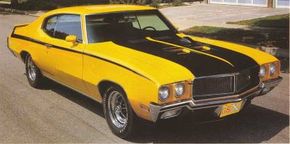Despite respected Buick muscle cars such as the GS 400 and mighty GSX, the "gentleman's car" division of General Motors was an unlikely source of high performance in the 1960s and early '70s.
Buick's traditional market position put it a step below Cadillac on GM's prestige scale. Buicks were dignified, often described as "doctors' cars." When the marque finally got around to producing genuine muscle cars, it's little surprise they were among the most luxurious of the breed. Buick's entry into the muscle car market came in 1965, in the wake of the wild success of the Pontiac GTO.
Advertisement
Buick had offered Gran Sport options for the Riviera and the Wildcat; these were touted as "manly" luxury cars, not hot muscle machines. That approached changed midway through the '65 model year with introduction of the Gran Sport version of Buick's Skylark, which shared its basic design with the Tempest that Pontiac used for the basis of the GTO.
The Skylark GS used a 325-bhp version of Buick's 401-cid "nailhead" V-8 (advertised at 400 cid to stay within GM's 400-cid ceiling in intermediate-size cars). Along with the big V-8, the GS package included a heavy-duty suspension, oversize 14-inch tires on attractive road wheels, dual exhaust, optional performance axle ratios, and assorted Gran Sport emblems. The 401 continued for 1966 and then was replaced for '67 by a new, thinwall-cast 400-cid V-8 rated at 340 bhp.
Shadowing the GS 400 was Buick's low-priced junior muscle car, the GS 340. Rated at 260 bhp, the 340 didn't exactly send Hemi Road Runner drivers fleeing, but along with the later 280-bhp GS 350 models, did provide Buick performance for those who couldn't swing the price of the luxury-oriented GS 400.
In 1970, GM lifted the 400-cid V-8 limit in intermediate-size cars, and Buick responded with its quickest cars yet, and some of the mightiest muscle cars of the era.
A handsome new body style bowed in 1970 to go along with the Skylark's new 455-cid V-8. Standard horsepower was a healthy 350, but a Stage 1 option for the GS made 360 thanks to a hotter cam and high-rpm valvetrain. Hot Rod magazine tested a 1970 Stage 1 GS 455 with the 3.64:1 axle ratio and recorded a 14.4-second quarter-mile time, impressive for a 3,900-pound car.
The real stud of the Buick corral also came in 1970, with the outlandish GSX version of the GS. It blew away Buick's reserved look with a large rear deck spoiler, body-length stripes, and available Saturn Yellow paint. It blew away plenty of rivals, too. Armed with the standard 455 or the Stage 1 option, GSXs packed as much as 510 lb ft of torque, and car-magazine testers of the time regularly pulled down mid-13-second quarter-miles in these machines.
The Stage 1 option survived into the early 1970s in low-compression 270-bhp form, but the cars it served were far from true muscle machines. Buick would resurrect its midsize-car performance image in the mid-'80s with the Grand National and GNX, V-6 brawlers that did justice to their muscle- car ancestors.
For profiles, photos, and specifications of more Buick muscle cars, see:
- A new option package made the 1965 Buick Skylark Gran Sport the first Buick muscle car.
- Despite an available 340 bhp, the 1966 Buick Skylark Gran Sport was a civilized performer, not a bare-knuckles street fighter.
- Renamed in honor of its new engine, the 1967 Buick GS 400 was a well-kept muscle car secret.
Return to Muscle Car Information Library.
Advertisement
